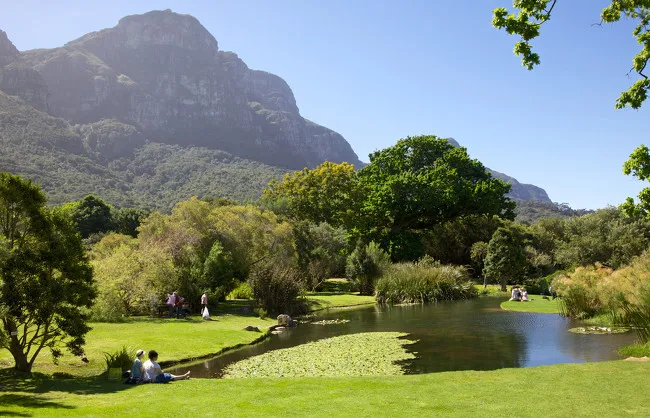The Kirstenbosch National Botanical Garden is listed as one of the world's great botanical gardens. And few can match its grandeur and idyllic location, along the eastern slopes of Table Mountain in Cape Town, Africa. It was the first botanical garden in the world to be declared a World Heritage Site.
 |
| Kirstenbosch National Botanical Garden |
Kirstenbosch was established in 1913 to promote, conserve and display the extraordinarily rich and diverse flora of southern Africa, and it was the first botanical garden in the world to be dedicated to the native flora of a country. Since its inception, it displays a wide variety of unique flora, as well as plants from all the various southern regions of the continent, outdoors as well as in the Society's Botanical Conservatory. The entire territory is home to more than 7,000 species, including many rare and threatened species. The 36 hectare garden on a 528 hectare estate is located in the heart of the Cape Floral Region, also known as the Cape Floral Kingdom.
 |
| Kirstenbosch National Botanical Garden |
Its beginnings and its present time. Professor Harold Pearson, an expert in botany, came to South Africa in 1903 to take up the newly created post of Botany at the University of South Africa and saw the need for a botanical garden in Cape Town and did what he could. to achieve that goal. From the hand of Neville Pillans, a young botanist and gardener, who knew perfectly the location of Kirstenbosch, he showed him the place and Harold Pearson, when contemplating the landscape of the place, exclaimed: “This is the place!”. In May 1913, the government reserved ownership of Kirstenbosch for the establishment of the Botanical Garden.
Today, the property covers 528 hectares, of which 36 are cultivated and the rest are destined to a protected area of natural forests and fynbos, run by a great variety of native birds, animals, reptiles.
 |
| Kirstenbosch National Botanical Garden |
The components of the garden.The eastern slopes of Table Mountain form the magnificent backdrop to Kirstenbosch. The rocks that make up Table Mountain and the Cape Peninsula are testimonies of the garden's history: of what existed in antiquity and the shape of the space that has developed over the years, until reaching what that is known today. The garden stands on top of a large mass of silvery-gray rocks and is bordered by rocky 1085-meter-high cliffs. Also, you can see the different layers of pink and brown sedimentary rocks that make up the 400 meter thick Graafwater formation. Sedimentary rocks are formed by the slow deposition of sand and mud in the water.
 |
| Kirstenbosch National Botanical Garden |
The flora. Regarding the vegetation of the area, there are two main types in the Kirstenbosch natural area: Fynbos and the forest. All the natural space can be explored through a series of walks and trails. Kirstenbosch supports three types of Fynbos, each occurring on soils derived from different rock types: Fynbos Granite Peninsula, on lower slopes and valleys; Fynbos Sandstone Peninsula, on the middle and upper slopes; and the Fynbos 'Cape Winelands Shale', in the northeast around the former colonial estate of Kirstenbosch. The Fynbos peninsula is characterized by the presence of tall shrubby proteas, dense cover of ericas and other shrubs such as heather, and restios.
 |
| Kirstenbosch National Botanical Garden |
In Kirstenbosch, the forest is found on the kloofs and on the slopes below the highest peaks. Thousands of trees were felled for wood in the late 1600s and 1700s, followed by the planting of exotic trees, thus reducing the native species in the area. The Kirstenbosch forests have been protected since the Botanical Garden was established in 1913. In the 1960s, exotic species were eradicated and the territory began to regenerate and recover naturally with the typical vegetation of the African continent. Tree species that can be seen at Kirstenbosch include Ilex mitis (Cape Holly), Podocarpus latifolius (Royal Yellowwood), Ocoteabulada (stinky), Ventosa Olinia (hard-pear), Cunonia capensis (red alder or rooiels).
 |
| Kirstenbosch National Botanical Garden |
The inhabitants. Regarding the fauna, birds are very abundant in the garden, since more than a total of 125 species have been registered. Many animals live and breed in and around Kirstenbosch, but they are not seen often because they are active especially at dusk or night and hide during the day. Table Mountain is home to a rich insect life and summer is the best time to witness butterflies of all kinds. The most spectacular is the Aeropetes Tulbaghia, which is attracted to and pollinates the red flowers. On the lower slopes and in the streams, the visitor can also frequently witness turtles and lizards. In short, the good weather conditions and the care of the Botanical Garden make possible the existence of a great diversity and its good development.
Kirstenbosch is a multipurpose space
The iconic Kirstenbosch landscape is also an ideal setting for art performances. So much so, that it represents a great variety of exhibitions, both in the open air, of long and short duration. Also, other activities such as conferences, weddings, concerts, among others, are carried out.